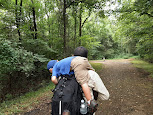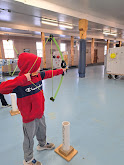The Language of Goals
 |
Summer
sledding. |
Just like most everything else in life, there is a particular language that goes along with being successful. When you think about an industry or profession, there is a common, shared set of language (jargon, slang, inside jokes, etc) that go along with making the team a team. Similarly, when we start talking about goals, we end up with shared language that helps get everyone on the proverbial same sheet of music, so to speak. When we're starting out with goals and actions toward more intentional life, it's important that we socialize and agree upon the foundational vernacular we'll be using so that we have a shared, common understanding of who, what, and how we're going to build our goals...and achieve them. To get started, here are a few that can help you begin to get joint language and concepts:
 |
| On the outside of a bridge. |
Mission, Vision, Values - these are often touted as the "big three" in studies of organizational leadership. They're charting the course for where the team will be going. They can be loosely equated to the "what we do," the "why we do it," and the "how we go about getting it done." These are loftier and above the tasks or tactics level...but should inspire the actions that will make up those tasks, timelines, and tactics.
 |
Medieval
fest. |
ICS Priorities - The Incident Command System (how we fight disasters) outlines four high-level priorities: life safety, incident stabilization, property conservation, and societal restoration. This ordering allows responders to focus on the first things first and keep a balance/assign resources. At home, we should have a similar set of priorities that guide our system. This could look like "we prioritize dinner around the dinner table" as a clear statement instead of cruise control, where the schedule eats up our unstated priorities.
 |
| Swing high. |
Objectives, strategies, tactics - this is perhaps the next level down in the proverbial pyramid where we begin to set concrete objective statements that will help us carry out actions necessary to achieve our desired mission. The objectives are written "SMART"ly, and then our strategies are a set of big-bucket alternatives that may get us to the finish line. This is then further fleshed out when we select a strategy by writing tactics that will be specific actions necessary to "do the thing."
 |
| Take the dog. |
Task, Purpose, End State - this set of words can help us communicate the selected strategies and tactics to the "worker bees." When we talk about this, it's equating and drawing the picture of how an individual's work to the greater efforts. For our families, this helps us connect the small daily habits of today to the grandiose outcomes you desire years from now.
 |
| Stop and search. |
Timelines, Tools, and Task (and Checkbooks/Calendar Appointments) - when we break down the big rocks into even smaller rocks, it takes the form of calendars, budgets, to-do lists, and so forth. When we do the first things (above) first, then our smaller level items can nest with trajectory toward the big things. In other words, if we know that we want to spend quality time with our family...that translates into not filling every moment with things like travel sports. Similarly, we don't "buy" some of the ethereal items (an adventurous family)...we spend the money at the task level (saying yes to the canoe on the Facebook Marketplace).
 |
| Ask the beaver. |
Management Action Points (MAPs) and Triggerpoints - along the way, we can set up triggers or mileposts that remind us to stop and have a conversation or make a decision. This could be the good things like anniversaries or Christmas traditions, or the bad things, like layoffs, sickness, and so forth. Without proactive and intentional consideration, we likely will be overcome with the stress and chaos of a situation that can, unfortunately, derail and erase our progress.
 |
| Learn to fish. |
Branches and Sequels - this concept is looking out ahead to the known (or anticipated) changes in life. With seasons, we can assume that some seasons will start/end, and we should have a sequel plan. For example, we should hopefully think about early elementary...while we're in toddler years, so we're more intentional. We can use the idea of branch planning (picture a tree trunk), where there is a shift away from the main plan - job change, moving across country, etc.
Courses of Action - too often in planning, we artificially put in constraints that aren't really there - "I could never leave this job because there are no other jobs." When we force ourselves to craft alternate scenarios or courses of action, we can get out of short-sightedness and make a decision in the moment that better aligns with our priorities and objectives.
 |
Watch the
Thunderbirds |
Pitfalls and risk assessment/mitigations - bad things will happen...and, in large part, are fairly predictable. When we look around the proverbial corner, we can hopefully identify the current actions to change our course. For example, the convenience of the screen "babysitter" when the kids are little...left unchecked...we'll raise screen addicted adolescents. The idea is to identify trouble as far on the horizon as possible.
 |
Climb a tree
to see farther. |
Progress review and course correction - along the way, we need to check in. The idea of 1% or 1 degree off course having crazy results when done over a long distance is very true. We have to check in with ourselves and our loved ones periodically that we're on the right track...and change if necessary. This can be connected to temporal landmarks - birthday, new year, etc.
Celebrations - slogging along with your head down can get you a ways...you can likely (and your family) can keep the pace much longer when you build celebrations along the way. They don't have to be expensive, just intentional and meaningful. This can take the shape of a family movie night, staycation, vacation, new family toy, etc.
 |
| Or just for fun. |
Systems - to wrap it up, hopefully you've gotten the idea that "systems are better than goals." Goals are great - they point the direction we should be heading. But...without the systemized actions, the proverbial train of life will run us over if we're just sitting on the tracks. We can use habits to add meat to the skeleton of our system. Let the "things" you do help fill the wind in your sails to get you where your goal-storming pointed you and your family.
With you in the arena, from ours to yours...Happy Trails!
Call to Action:
- Pick out a couple of items above that resonate with you and talk through it with your family.
- 1 - ___________________
- 2 - ___________________
- 3 - ___________________
- Discussion: Consider what you/your family could/would/should (level of commitment) and start/stop/sustain (action) in terms of goals or systems.
Further Reading, Motivation, and References:
- Stephen Covey - 7 Habits of Highly Effective Families
- Family Planning Schedule
































































